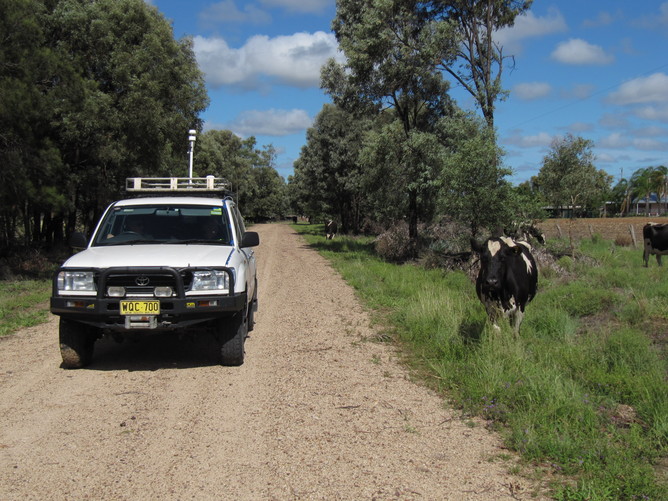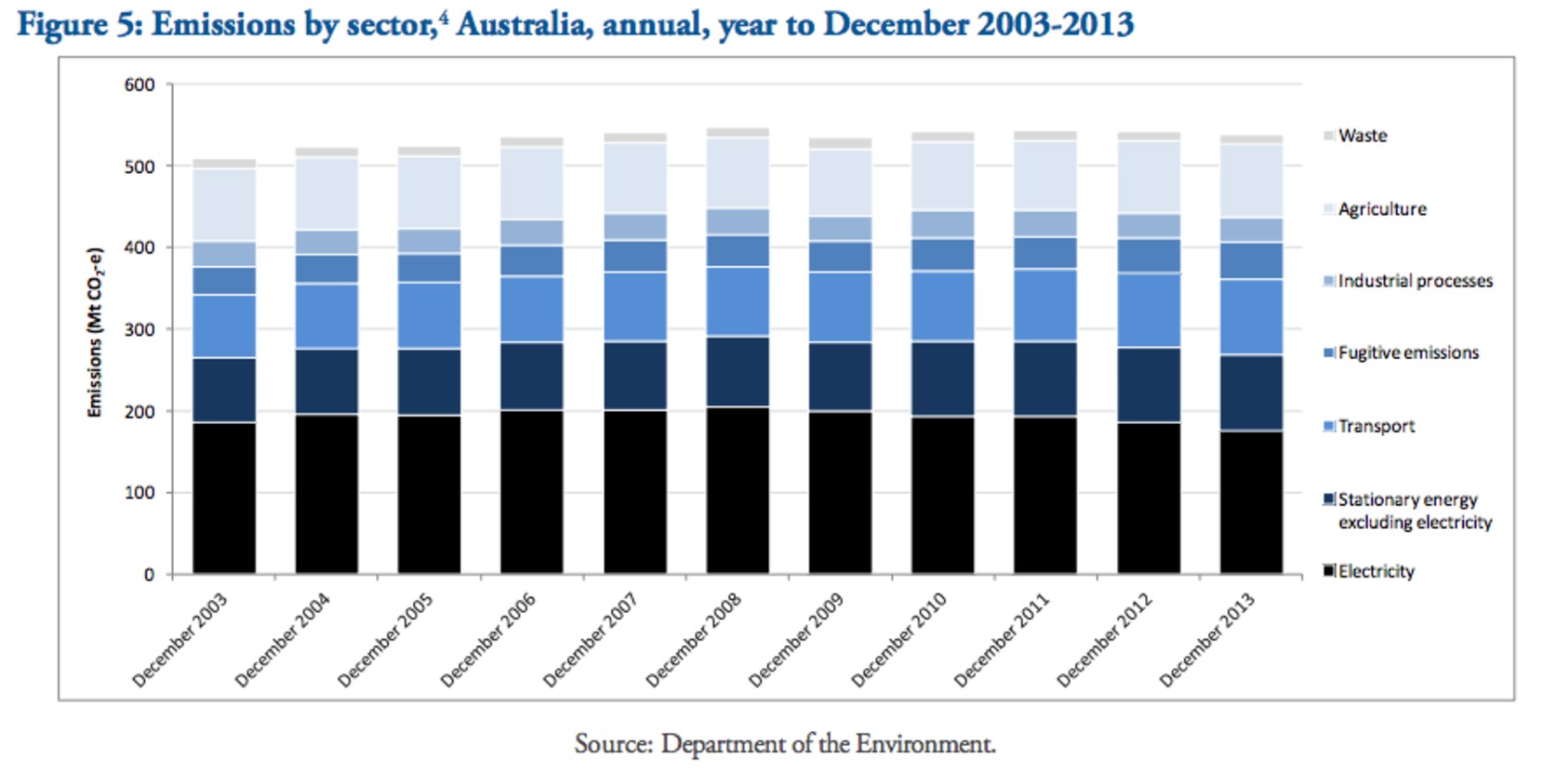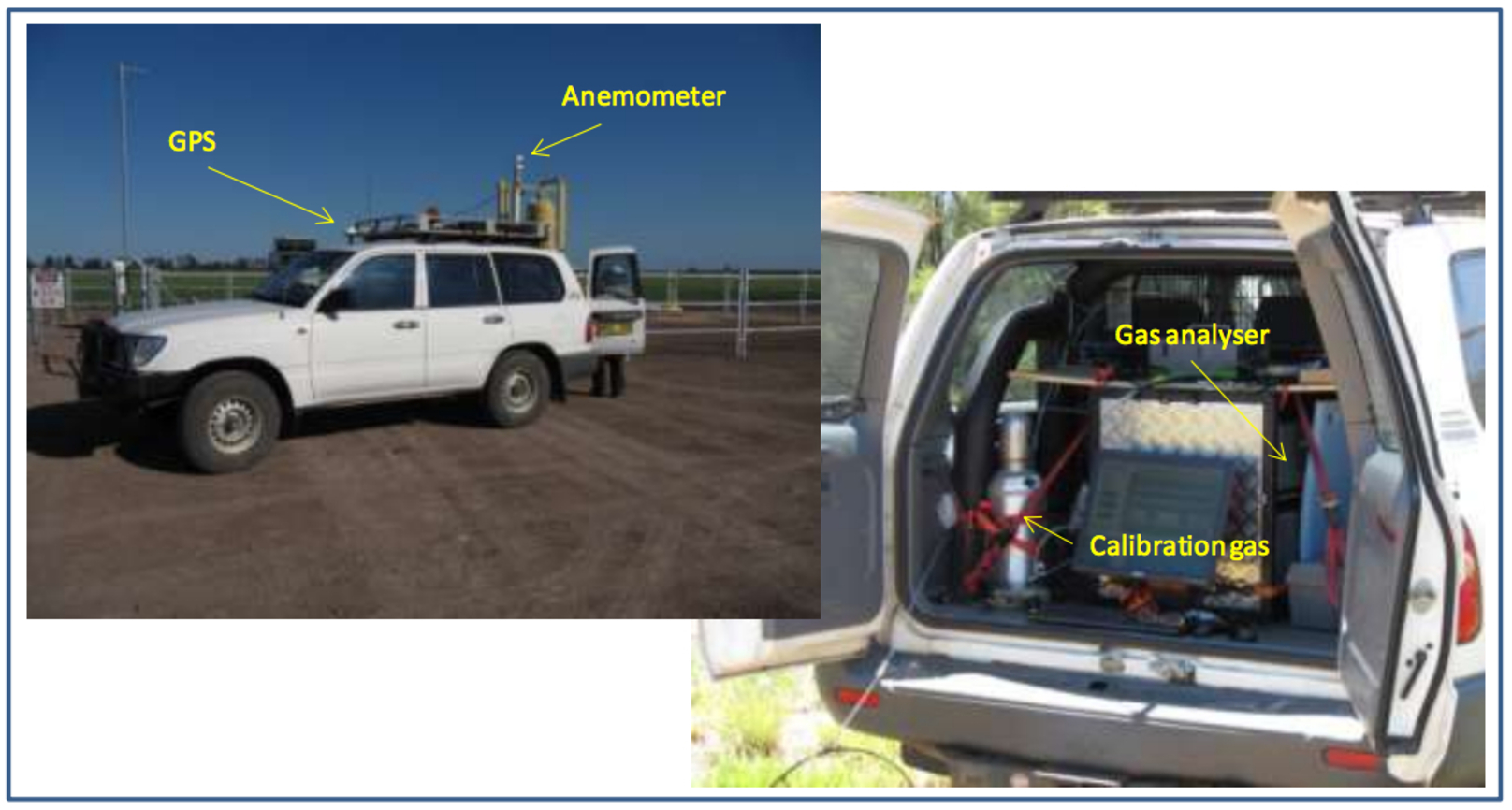
The methane-detecting four-wheel-drive, measuring emissions around Queensland and NSW coal seam gas wells. Tests were also done upwind of each site to avoid cows or other methane sources skewing the results.
By Damian Barrett and Stuart Day
One of the most common questions Australians ask about coal seam gas is whether the gas wells leak – and if so, how much?
In the first Australian study of its kind, new CSIRO research now gives an indication of how much those “fugitive emissions” might be, and how we can start to reduce them.
Commissioned by the federal Department of the Environment and now published on its website, the pilot study measured emissions around 43 coal seam gas production wells – six in New South Wales and 37 in Queensland – out of the more than 5000 wells currently operating around Australia. The results reveal that:
- nearly all of the 43 wells tested showed some fugitive emissions;
- the emissions rates were very low (in most cases less than 3 grams of methane per minute – equivalent to methane emissions from around 30 cows);
- in many cases, those emissions could be reduced or even stopped entirely; and
- the average measured levels from the Australian wells were 20 times lower than reported in a study of fugitive emissions from US unconventional gas sites, published last year in the leading international journal Proceedings of the National Academy of Sciences
In Australia, fugitive emissions from coal mining, oil and gas production account for about 8% of Australia’s greenhouse gas emissions.
From the latest report on Australia’s greenhouse gas emissions, published by the federal Department of the Environment in April this year. Click to enlarge
Although those fugitive emissions are estimated and reported under the National Greenhouse and Energy Reporting Act, there has often been a high degree of uncertainty associated with these estimates in Australia – particularly from coal seam gas production.
That’s why this new research is important, as it offers a first indication of fugitive emissions from coal seam gas under Australian conditions.
Pressure regulator
The report found a particular type of pressure regulator installed at many wells was a common source of methane leakage.
The report’s results
Our new report, Field Measurements of Fugitive Emissions from Equipment and Well Casings in Australian Coal Seam Gas Production Facilities, shows that of the 43 wells studied, three had no detectable leaks.
Of the rest, 37 wells emitted less than 3 grams of methane per minute, and 19 of those showed very low emission of less than 0.5 grams of methane per minute.
However, at a few wells (6 of the 43) much higher emissions rates were detected, with one well registering emissions 15 times higher than the study average. That was found to be mainly due to methane discharging from a vent on a water line.
On closer scrutiny, some of the leaks were due to faulty seals on equipment and pumps, which could be easily fixed, while other emissions were associated with exhaust from gas-fuelled engines used to power water pumps that are not regarded as “fugitive” emissions.
We tested for emissions using a four-wheel-drive fitted with a methane analyser. The car made several passes downwind from the well to measure total emissions emanating from the site.
To ensure that other potential methane sources, such as cattle, were not inadvertently included, similar measurements were made upwind of each test site. We also took a series of measurements at each well to locate sources and measure emission rates.
The methane-detecting 4WD and its equipment
Why worry about fugitive emissions?
Fugitive emissions occur when methane escapes from production facilities, wells, pipes, compressors and other equipment associated with coal mining or natural gas extraction. Other human induced methane emissions occur through grazing of domestic stock, agricultural production and from landfills.
In nature, methane is released from geological sources and biological processes occurring in wetlands, swamps, rivers and dams. About 15% of human emissions of methane are derived from fossil fuels.
While burning gas for energy has lower greenhouse gas emissions compared to other fossil fuels like coal, methane has a global warming impact at least 25 times that of carbon dioxide (when measured over a 100 year period).
Even small losses of methane during gas production, processing and distribution have the potential to reduce the relative greenhouse benefit of natural gas as a fuel for electricity production.
Fugitive emissions can be costly for the coal seam gas industry because escaping gas represents a loss of a valuable commodity.
What’s next for CSG emissions research?
These new findings from 43 wells are a good start, but they are clearly only the beginning, given that represents fewer than 1% of Australia’s coal seam gas wells. More measurements are required to representatively sample the remaining 99% of wells before we can make definitive statements about methane fugitive emissions in Australia.
CSIRO scientists, through the Gas Industry Social & Environmental Research Alliance (GISERA), are undertaking further research into methane emissions in Australia including understanding the natural or background emissions of methane that come from seeps in the ground in Queensland’s Surat Basin.
This research aims to identify background sources of methane and determine the best detection and measurement methods.
Results from measuring naturally occurring methane seepage, as well as the results of this new report and others, will add to the bigger picture of assessing the coal seam gas industry’s whole of life cycle greenhouse gas emission footprint. Most importantly, we hope they will provide more answers to Australians’ question about coal seam gas.
This article was originally published on The Conversation.
Read the original article





1st August 2014 at 9:35 am
This is a great start, can the CSIRO confirm that, like the CSG Compliance Unit in Qld, they needed to get permission from the gas companies to test the wells. If they had to get permission from the gas companies, was this permission gained on randomly selected gas well numbers, or were the wells suggested by either the Qld. government or the companies. I think either way it would be good if on the next series of tests 43 gas wells suggested by landowners would give a significantly higher levels and an average should be made. I’m very happy to volunteer my time and organize interested landowners. I believe the gas wells are a far less significant source of emissions than the high point vents on pipeline, these vent untreated gas at alarming rates. Please consider randomly testing these high point vents, I have many in mind that vent quite violently. But as I say this is a great beginning, it would be great if landholder involvement was included, and not just positive land holders. I can find hundreds of negatively impacted landowners to show you their sad stories.
1st August 2014 at 7:52 pm
Agree fully with Brian Monk’s viewpoint.
4th August 2014 at 3:25 pm
Hi Brian, thanks for your questions. I’ve checked with the report authors and included their response below:
“We did get permission from each company to gain access to their sites. To select the wells for testing, we asked each participating company to provide us with a list of their wells, from which we chose a subset for testing. We then selected wells to provide a range of different well types (vertical vs horizontal), age, production rate, and so on. The wells selected for testing were not suggested by the companies or government agencies.
As we acknowledge in the report, this is only a small sample, so it would worthwhile expanding the sample size in any future study, as you have suggested. In relation to high point vents, we agree that these vents may emit significant amounts of gas, but detailed measurements of these were outside the scope of this project. We do note in the report, however, that further work to investigate high point vents along with other infrastructure is required to fully account for methane releases from CSG production.”
4th August 2014 at 3:57 pm
Thank you for the reply. As I read the report more deeply I saw you cited the limitations. I guess it is just a pity that such a superficial result was reported by such a senior representative of the csiro. As expected the industry has seized on the good name the csiro has had and put this initial report forward as science. A scientific begining it is but science it is not. I look forward to read
ing the exact gases and quantities of gases the central processing plants are releasing as I live nearby and have suffered many health issues since csg began in my neighborhood. We also have an imacted bore we would love the csiro to investigate.
7th August 2014 at 9:16 am
Yes I agree with Brian , I also would like to point out that the dangerously high levels of benzene found in the water of a friend’s property meant that the landholder’s cows would not drink the water. Can we also get measurements of other chemicals,acids and toxins which are released as a result of coal seam gas mining, mineral mining and coal mining. When you consider this the idea that coal seam gas damages the ozone and surrounding biosphere, less than the amount 30 cows do, is quite incongruous.
1st August 2014 at 8:40 am
Could we have some news on your research into solar, wind and wave power?
1st August 2014 at 9:05 am
Where to start? You can get to a lot of news on these by going to http://ow.ly/zOHGT, http://ow.ly/zOHBd and http://ow.ly/zOHun